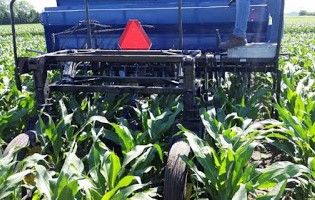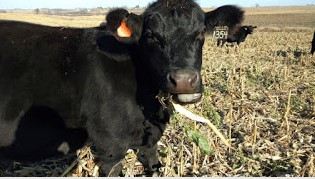Four southeastern Minnesota farmers, the Cannon River Watershed Partnership (CRWP) and the University of Minnesota are addressing that challenge. They are pairing wide-spaced corn rows with cover crops to test whether both economic and ecological outcomes could be improved.
Why wider rows?
Row spacings vary between operations, crops, and locations across the U.S., but generally, corn is typically managed in 30-inch rows. For 40 years or more, crop rows have narrowed to maximize sunlight interception and subsequent profitability. As a result, thirty-inch corn rows are broadly accepted as a best management practice with the highest return on investment.
If wider-spaced crop rows reduce the amount of light captured by the crop and ultimately reduce yield, why might farmers be interested in this type of technology? One possibility is to provide farmers a dual-output system of corn grain and forage where both outcomes are economically linked to sustainability goals.
On-farm trials
In 2018, the CRWP was awarded a Sustainable AGRI grant from the Minnesota Department of Agriculture to assess wide-row corn productivity trade-offs in a dual-use cropping system. Four interested farmers, the CRWP and University of Minnesota designed a field study that was implemented in southeastern Minnesota counties. The goal of this project was to balance these potential corn grain reductions with improved forage biomass production for the farmers’ cattle.
Field study design
Each of the four farms in southeastern Minnesota included four 5-acre replicates for a total of 80 acres across the farm network. This was the first year of a 3-year project.

A high-clearance drill made interseeding the
forage cover crop mix a breeze in seven-leaf
stage corn.
- Tillage - the farmers used a suite of conservation tillage technologies (e.g. shallow vertical tillage and no-till soybeans)
- Study treatments
- 30-inch row corn with cover crop
- 30-inch row corn without cover crop
- 60-inch row corn with cover crop
- Cover crop mixtures - two mixtures were developed for each of the the counties. Farmers selected the cover crop mixtures with the main goal of producing high forage yield and quality (e.g. annual ryegrass, clovers, kale, radish, turnip and cowpea).
- Interseeding cover crops - Cover crops were interseeded into knee-high corn in mid-June to early July with modified drills and air-seeders.
Preliminary results
As expected, the 60-inch wide-row corn treatments reduced corn yields per acre overall by 20% relative to the 30-inch treatments, both with and without a cover crop. Yield data will be available in a follow-up article at a later date.

Cattle grazing cover crop forage and corn stalks
in Faribault, Minn. made their preferences known
by devouring the forage quickly.
On the other hand, the amount of biomass the interseeded cover crop created in the 60-inch row treatment was greater than expected. In September, sampling showed an average of more than 1,500 pounds per acre of high quality dried forage. For reference, my team has interseeded more than 2,000 cover crop test plots over the past 6 years, and fall cover crop biomass is typically less than 200 pounds of dry matter per acre.
After corn harvest, cattle were sent to glean the field. One of the farmers stated that his cattle devoured the cover crop forage very quickly.
Preliminary economic analysis
A recent preliminary analysis by Dr. William Lazarus, agricultural economist with the University of Minnesota, revealed that high yielding, high quality cover crop forages (appox. 800 pounds per acre dry matter and greater) can offset up to 10% of corn grain reductions through the production of milk and muscle, even without accounting for the soil health or environmental benefits.
First-year summary
The results from the first year of this three year study showed that wide-row corn reduced grain yields. The results also showed that when farmers have access to animals, wide-row corn, paired with cover crops that produce large quantities of high-quality forage, can provide corn farmers with an improved bottom line by substituting high-cost hay with those grazed covers. These early results may encourage greater adoption of cover crops and improved water quality for all Minnesotans.
Source : umn.edu